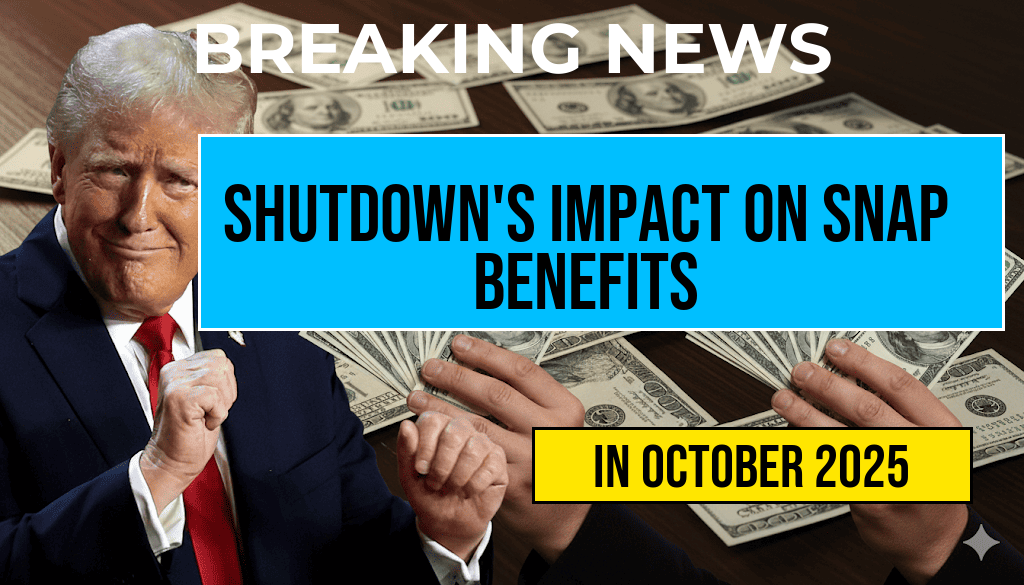The recent federal government shutdown has raised concerns across numerous social programs, particularly the Supplemental Nutrition Assistance Program (SNAP), commonly known as food stamps. With federal agencies operating under temporary funding, many households relying on SNAP face uncertainty about their benefits. While some services continue at limited levels, funding disruptions threaten to delay or reduce benefits, impacting millions of Americans who depend on these resources for daily sustenance. The shutdown’s specific effects on SNAP depend on the duration of the funding lapse, congressional decisions, and administrative responses. As lawmakers debate funding agreements, recipients are urged to stay informed about potential changes and prepare for possible disruptions.
Current Status of SNAP Funding Amid the Shutdown
As of now, the U.S. Department of Agriculture (USDA), which administers SNAP, has implemented contingency plans to ensure program continuity during the funding hiatus. However, these measures are temporary and vary by state and local level. Typically, SNAP benefits are disbursed via electronic benefit transfer (EBT) cards, with payments scheduled monthly. During previous shutdowns, the USDA has authorized states to continue issuing benefits for a limited period, often up to one month, relying on funds already allocated or emergency appropriations from Congress.
In the current situation, some states report that benefits scheduled for release may proceed without interruption, but others warn of potential delays if federal funding is not restored swiftly. The USDA’s Food and Nutrition Service (FNS) provides regular updates on the status of SNAP operations during government funding gaps. Nonetheless, the uncertainty remains high, especially if the shutdown extends beyond initial contingency periods.
Potential Changes to SNAP Benefits Due to the Shutdown
Benefit Disruptions and Delays
- Delayed benefit issuance: Households may experience delays in receiving their monthly benefits, leaving families without access to food assistance during critical periods.
- Reduced benefit amounts: In some cases, states could face constraints that lead to pro-rated benefits or temporary reductions, especially if emergency funding is insufficient.
- Administrative bottlenecks: Staffing shortages and limited federal oversight may hinder timely processing of applications, recertifications, and other administrative functions.
Impact on Vulnerable Populations
Low-income families, seniors, and individuals with disabilities are particularly vulnerable to disruptions in SNAP benefits. Unanticipated delays can result in food insecurity, increased reliance on emergency services, and adverse health outcomes. According to data from the USDA, approximately 42 million Americans participate in SNAP, underscoring the program’s role in alleviating poverty and hunger.
Legislative and Administrative Responses
Congressional Negotiations
Efforts are underway in Congress to reach a funding agreement that could end the shutdown. Lawmakers are considering several proposals, including temporary funding extensions and longer-term budget deals. Some members advocate for emergency appropriations specifically designated for nutrition programs, aiming to prevent disruptions during the impasse.
While negotiations continue, the USDA and state agencies are preparing contingency plans, including extending benefits where possible and providing guidance to recipients on how to manage potential delays.
State-Level Measures
States have varying capacities to mitigate the shutdown’s effects. Some are using reserve funds or reallocating resources to ensure continued benefits, while others are advising residents to monitor official channels for updates. State agencies are also coordinating with local food banks and community organizations to support those facing immediate food insecurity.
What Recipients Should Do
| Action | Description |
|---|---|
| Monitor official communications | Check updates from your state SNAP agency and the USDA for information on benefit issuance and potential delays. |
| Plan accordingly | If benefits are delayed, consider purchasing non-perishable food items in advance or seeking assistance from local food banks. |
| Stay informed about legislative developments | Follow credible news sources and government websites to understand when funding might be restored. |
| Contact local agencies if needed | Reach out to your state or local SNAP office for guidance and support options during this period. |
Looking Ahead
The ongoing debate over federal funding highlights the fragile nature of social safety net programs like SNAP. While contingency plans help mitigate immediate disruptions, prolonged shutdowns threaten to undermine the program’s stability and effectiveness. Policymakers face increasing pressure to reach bipartisan agreements that prioritize essential services, including nutrition assistance, especially for the most vulnerable populations. For now, recipients are encouraged to stay vigilant and utilize available resources to navigate potential challenges.
For more detailed information on SNAP and government shutdown impacts, visit the USDA Food and Nutrition Service website or consult updates from your state’s social services department.
Frequently Asked Questions
What is a government shutdown and how does it affect SNAP benefits?
A government shutdown occurs when federal funding is temporarily halted due to the lack of approved budgets. During such periods, SNAP benefits and other assistance programs may face disruptions, potentially impacting recipients’ ability to access food assistance.
Will my food stamp benefits be reduced or delayed during a government shutdown?
Depending on the duration and specific circumstances of the shutdown, SNAP benefits may be delayed, reduced, or temporarily unavailable. It is important for recipients to stay informed through official channels for updates about their benefits.
Are there any measures in place to protect food stamp benefits during a government shutdown?
In some cases, emergency funding or temporary measures may be implemented to ensure that SNAP recipients continue to receive benefits without interruption. However, these measures vary and are not guaranteed during all shutdowns.
How can I check the status of my food stamp benefits during a shutdown?
Recipients should visit the official SNAP or state agency websites, or contact their local office directly, to get the latest information regarding their benefits and any changes resulting from the government shutdown.
What should I do if my food stamp benefits are delayed or reduced due to the shutdown?
If your SNAP benefits are affected, consider reaching out to local assistance agencies for support and guidance. It is also advisable to explore other community resources and emergency food programs until your benefits are restored.






